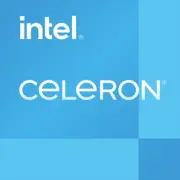Intel Celeron 877

Intel Celeron 877: Budget Processor for Basic Tasks in 2025
Analysis of the capabilities and relevance of an outdated chip in the era of modern technology
1. Architecture and Process Technology: Modest Specifications for Simple Tasks
The Intel Celeron 877 processor, released in 2011 on the Sandy Bridge architecture, is still found in ultra-budget laptops. Its technical specifications reflect an era when dual-core CPUs without multi-threading support were the norm for the entry-level segment:
- Cores and Threads: 2 cores, 2 threads (no Hyper-Threading).
- Clock Speeds: Base frequency — 1.4 GHz. Turbo mode is absent.
- Graphics: Integrated Intel HD Graphics (Sandy Bridge) with 6 Execution Units, operating at a frequency of 350–1000 MHz.
Architecture Features:
Sandy Bridge brought improvements in performance per clock and energy efficiency compared to previous generations. However, the 32-nm process technology and lack of modern instructions (AVX, AES-NI) render the Celeron 877 unsuitable for tasks requiring hardware acceleration.
Example: Playback of 1080p video is possible, but 4K content will lag even on YouTube due to the weaknesses of the iGPU and the absence of a VP9 decoder.
2. Power Consumption and TDP: Savings at the Cost of Performance
The Celeron 877 has a TDP of 17 W, which is typical for processors in this class. In 2025, such chips are found in compact devices with passive cooling.
- Advantage: Low heat generation allows for the creation of thin laptops without fans.
- Disadvantage: Under load (e.g., opening 10 tabs in a browser), throttling may occur due to the weak cooling system.
Advice: If you choose a laptop with this CPU, ensure the chassis has metal components for better heat dissipation.
3. Performance: Minimum for Survival
Geekbench 6 tests (241 / 370) show that the Celeron 877 lags behind even modern smartphones. Let's consider it in real scenarios:
- Office Work: Word, Excel, browser with 5–7 tabs — delays may occur when switching between applications.
- Multimedia: Watching FullHD video, basic photo editing in Lightroom (only for the patient).
- Gaming: Only old games like Half-Life 2 or Minecraft on low settings (10–20 FPS).
Turbo Mode: Absent — frequency is fixed at 1.4 GHz. This limits performance under short bursts of load.
4. Usage Scenarios: Who Is Celeron 877 Relevant for in 2025?
This processor is suitable for those who do not require multitasking:
- Students: Note-taking, online lectures, PDF textbooks.
- Seniors: Email, video calls, simple browser games.
- Backup Laptop: For trips where there is a high risk of device loss or damage.
Important: Do not consider it for Zoom conferences while simultaneously working in Google Docs — freezes are inevitable.
5. Battery Life: Up to 6 Hours — If Lucky
With a battery capacity of 35–40 Watt-hours, working time reaches 4–6 hours in document reading mode. However:
- Energy Saving Technologies: Intel SpeedStep reduces frequency during idle to 800 MHz.
- Problems: The old 32-nm process lags behind modern 7-nm chips (e.g., Apple M1) in efficiency. Even budget AMD Athlon Gold chips on 6 nm (2024) consume less power while providing greater performance.
Advice: Disable Wi-Fi and reduce screen brightness to 50% to extend battery life.
6. Comparison with Competitors: In the Context of Modern CPUs
- AMD Athlon Silver 7120U (2024): 2 cores / 2 threads, 15 W TDP, 6-nm process. Geekbench 6: 980 / 1850. Laptop prices — starting from $350.
- Intel N100 (Alder Lake-N): 4 cores, 6 W TDP, supports DDR5. Geekbench 6: 1200 / 3200. Devices — starting from $300.
- Apple MacBook Air M1 (2020): Not a direct competitor, but for $600 offers 5 times more performance.
Conclusion: The Celeron 877 falls short even against budget models from 2024–2025, but can be useful if the budget is limited to $200–250.
7. Pros and Cons: When Price Justifies Disadvantages
Strengths:
- Laptop prices starting from $200.
- Sufficient for Linux distributions (Lubuntu, Xubuntu).
- Repairability — replacing an SSD or RAM will be inexpensive.
Weaknesses:
- No support for Windows 11 (only unofficial patches).
- Slow SSD (often a 64 GB eMMC storage).
- Absence of USB-C and Wi-Fi 6.
8. Recommendations for Choosing a Laptop: What to Check Before Buying
Type of Device:
- Ultra-budget Laptop: For example, HP Stream 14 or similar models.
- ChromeOS Device: Some Chromebooks use Celeron 877, but it’s better to look for options on ARM.
What to Pay Attention To:
1. RAM: At least 8 GB (but often 4 GB — avoid such models!).
2. Storage: Only SSD (256 GB and above). eMMC is a nightmare.
3. Display: IPS matrix with a resolution of 1920×1080. HD+ (1366×768) is outdated even for basic tasks.
Example: Lenovo IdeaPad 1 (2025) with Celeron 877, 8 GB RAM, 256 GB SSD — $249. Suitable for Linux and light tasks.
9. Final Conclusion: Who Is Celeron 877 Suitable for in 2025?
This processor is an option for:
- Users with Minimal Needs: Browsing, text editors.
- Linux Enthusiasts: Lightweight distributions will breathe life into the old chip.
- Buyers on a Tight Budget: When $200 is the limit.
Key Benefits:
- Low price.
- Sufficient performance for basic tasks.
- Compatibility with most peripherals.
Alternative: If your budget allows for an additional $100–150, choose laptops with Intel N100 or AMD Athlon — they will last longer and won’t disappoint in the future.
The Celeron 877 is a compromise worth considering only in extreme economy conditions. In 2025, even the budget segment offers more favorable options.
Basic
CPU Specifications
Memory Specifications
GPU Specifications
Miscellaneous
Benchmarks
Compared to Other CPU
Share in social media
Or Link To Us
<a href="https://cputronic.com/index.php/cpu/intel-celeron-877" target="_blank">Intel Celeron 877</a>